Abstract
The success of cancer chemotherapy is dependent on the possibility to utilize biological differences between malignant and normal cells to selectively destroy the tumor cells. One such difference may be that of receptor-mediated cellular uptake of low density lipoproteins (LDLs). Previous studies have shown that leukemic cells from patients with acute myelogenous leukemia have elevated receptor-mediated uptake and degradation rates of plasma LDL in vitro compared to normal white blood and bone marrow cells, and that plasma cholesterol levels at diagnosis are inversely correlated with the LDL receptor activity of the malignant cells. An important question is whether the uptake of LDL by the leukemic cells is also increased in vivo. To evaluate the in vivo uptake of LDL, 11 adult patients with newly diagnosed acute myelogenous leukemia received an i.v. injection of [14C]-sucrose-labeled LDL. On degradation of [14C]sucrose-LDL, the radiolabeled sucrose moiety is known to remain trapped in the lysosomal compartment of the cells. After injection, radioactivity accumulated progressively for at least 12 hr in the leukemic cells. The uptake of radioactivity in vivo correlated with the rate of receptor-mediated degradation of 125I-labeled LDL by the leukemic cells assayed in vitro (r = +0.88, P less than 0.001). An inverse correlation between plasma LDL cholesterol concentrations and the in vivo cellular uptake of [14C]sucrose-LDL in whole blood (r = -0.76, P less than 0.01) indicates that the hypocholesterolemia is due to elevated LDL uptake by the leukemic cells. Postmortem biopsies from virtually all tissues were obtained from one patient, and the distribution of radioactivity revealed that the liver and bone marrow had accumulated most radioactivity; the adrenals had the highest uptake of label per gram of tissue weight. The results indicate that LDL may be used as a carrier targeting lipophilic cytotoxic drugs to leukemic cells.
Full text
PDF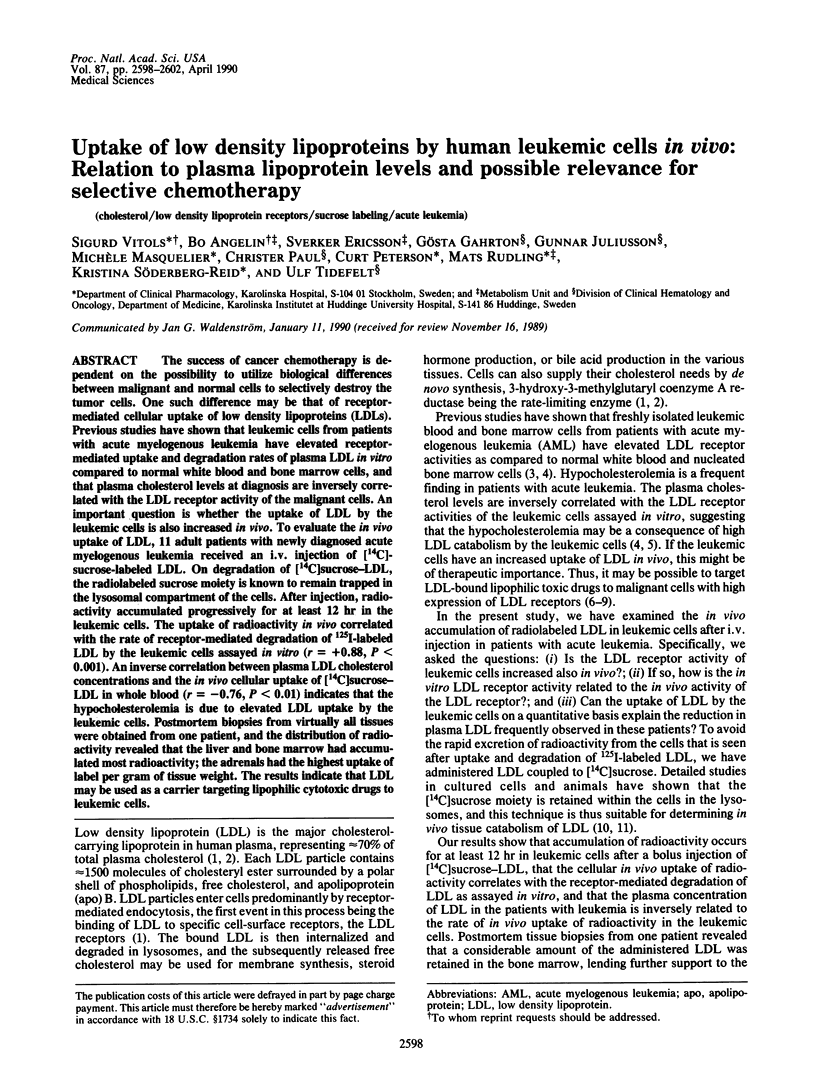
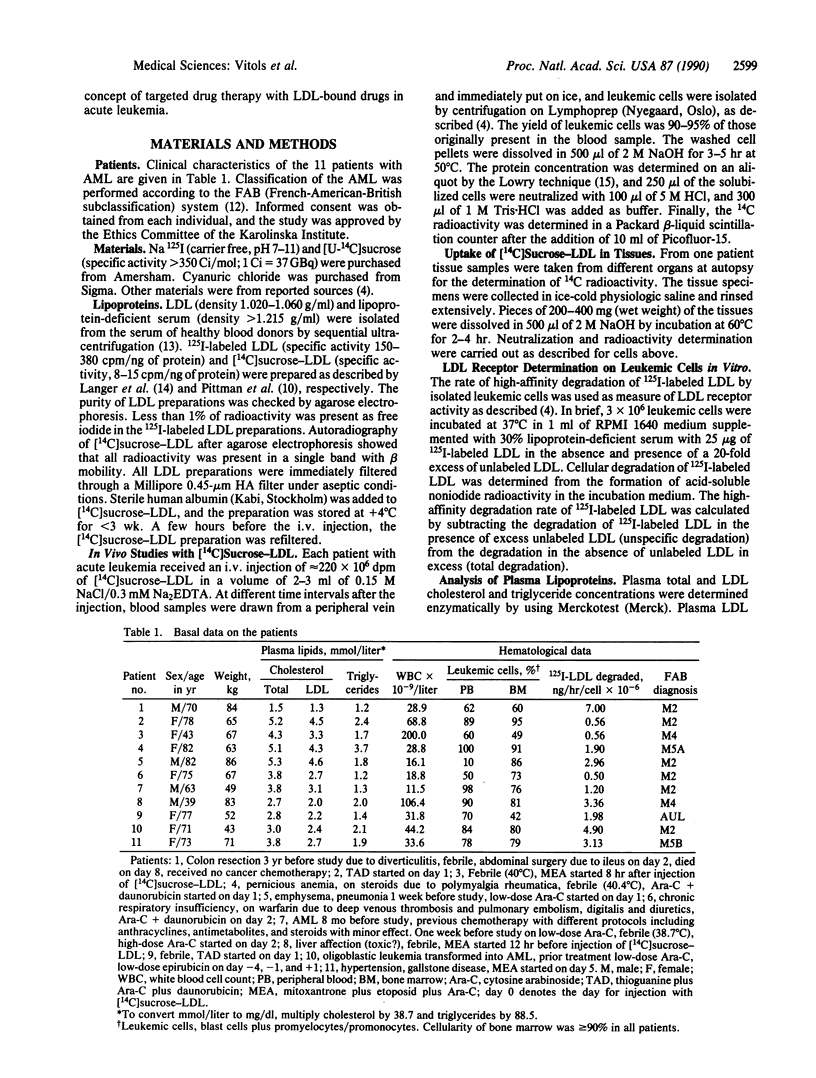
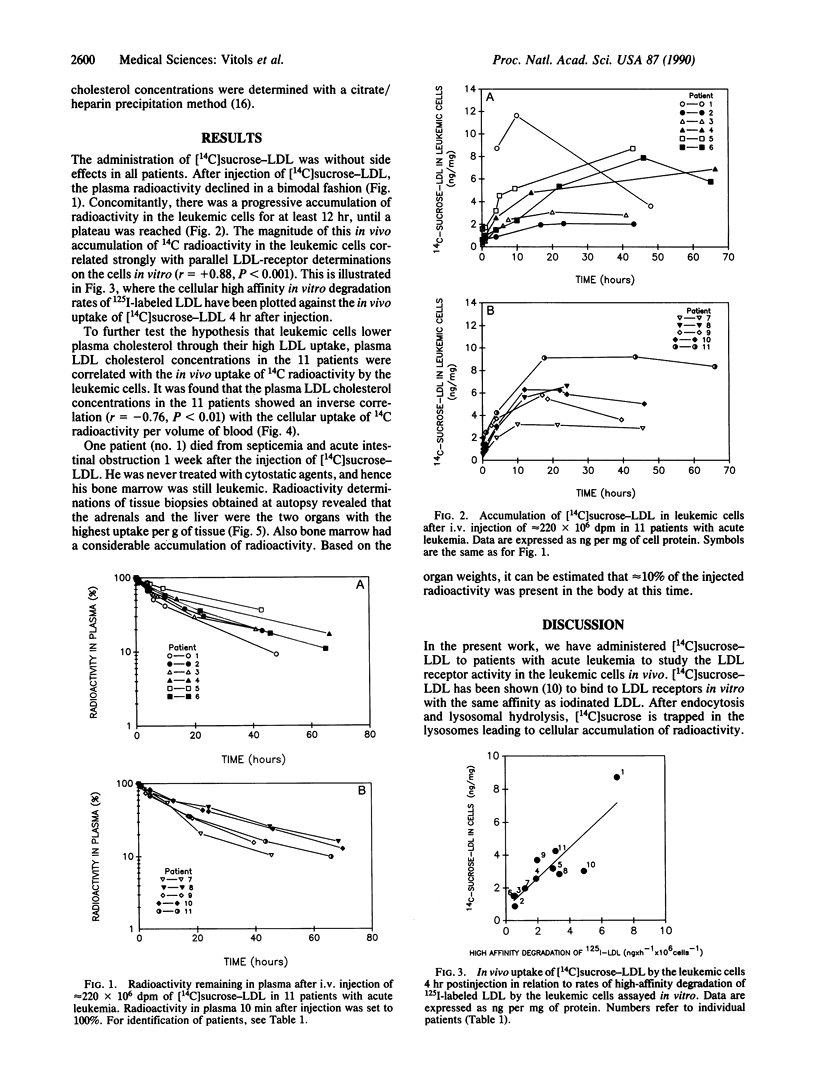
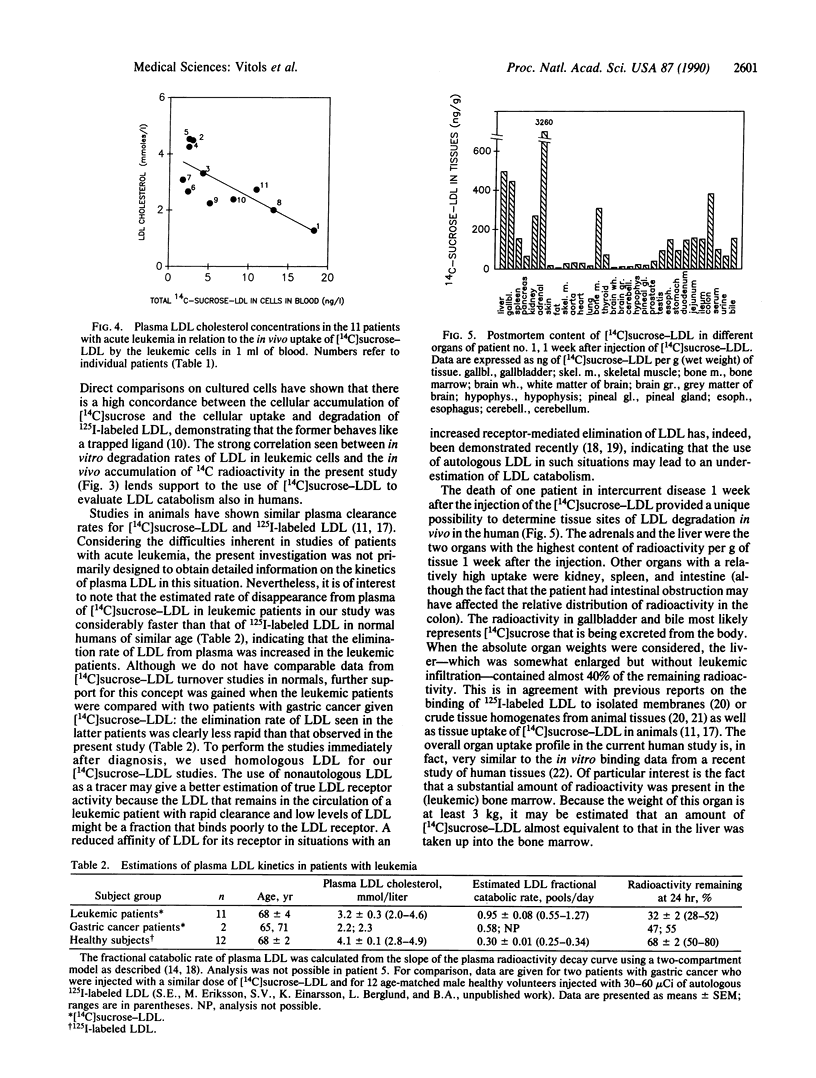
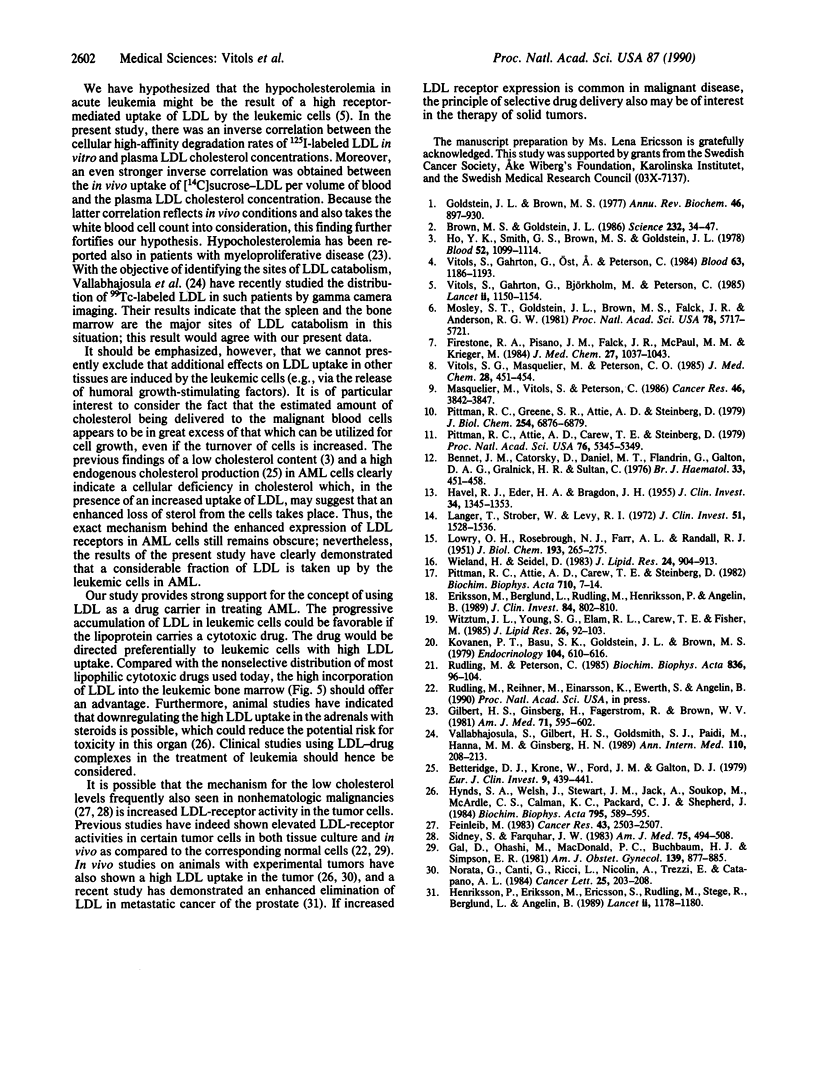
Selected References
These references are in PubMed. This may not be the complete list of references from this article.
- Bennett J. M., Catovsky D., Daniel M. T., Flandrin G., Galton D. A., Gralnick H. R., Sultan C. Proposals for the classification of the acute leukaemias. French-American-British (FAB) co-operative group. Br J Haematol. 1976 Aug;33(4):451–458. doi: 10.1111/j.1365-2141.1976.tb03563.x. [DOI] [PubMed] [Google Scholar]
- Betteridge D. J., Krone W., Ford J. M., Galton D. J. Regulation of sterol synthesis in leukaemic blast cells: a defect resembling familial hypercholesterolaemia. Eur J Clin Invest. 1979 Dec;9(6):439–441. doi: 10.1111/j.1365-2362.1979.tb00909.x. [DOI] [PubMed] [Google Scholar]
- Brown M. S., Goldstein J. L. A receptor-mediated pathway for cholesterol homeostasis. Science. 1986 Apr 4;232(4746):34–47. doi: 10.1126/science.3513311. [DOI] [PubMed] [Google Scholar]
- Eriksson M., Berglund L., Rudling M., Henriksson P., Angelin B. Effects of estrogen on low density lipoprotein metabolism in males. Short-term and long-term studies during hormonal treatment of prostatic carcinoma. J Clin Invest. 1989 Sep;84(3):802–810. doi: 10.1172/JCI114239. [DOI] [PMC free article] [PubMed] [Google Scholar]
- Firestone R. A., Pisano J. M., Falck J. R., McPhaul M. M., Krieger M. Selective delivery of cytotoxic compounds to cells by the LDL pathway. J Med Chem. 1984 Aug;27(8):1037–1043. doi: 10.1021/jm00374a017. [DOI] [PubMed] [Google Scholar]
- Gal D., Ohashi M., MacDonald P. C., Buchsbaum H. J., Simpson E. R. Low-density lipoprotein as a potential vehicle for chemotherapeutic agents and radionucleotides in the management of gynecologic neoplasms. Am J Obstet Gynecol. 1981 Apr 15;139(8):877–885. doi: 10.1016/0002-9378(81)90952-2. [DOI] [PubMed] [Google Scholar]
- Gilbert H. S., Ginsberg H., Fagerstrom R., Brown W. V. Characterization of hypocholesterolemia in myeloproliferative disease. Relation to disease manifestations and activity. Am J Med. 1981 Oct;71(4):595–602. doi: 10.1016/0002-9343(81)90212-6. [DOI] [PubMed] [Google Scholar]
- Goldstein J. L., Brown M. S. The low-density lipoprotein pathway and its relation to atherosclerosis. Annu Rev Biochem. 1977;46:897–930. doi: 10.1146/annurev.bi.46.070177.004341. [DOI] [PubMed] [Google Scholar]
- HAVEL R. J., EDER H. A., BRAGDON J. H. The distribution and chemical composition of ultracentrifugally separated lipoproteins in human serum. J Clin Invest. 1955 Sep;34(9):1345–1353. doi: 10.1172/JCI103182. [DOI] [PMC free article] [PubMed] [Google Scholar]
- Henriksson P., Eriksson M., Ericsson S., Rudling M., Stege R., Berglund L., Angelin B. Hypocholesterolaemia and increased elimination of low-density lipoproteins in metastatic cancer of the prostate. Lancet. 1989 Nov 18;2(8673):1178–1180. doi: 10.1016/s0140-6736(89)91790-x. [DOI] [PubMed] [Google Scholar]
- Ho Y. K., Smith R. G., Brown M. S., Goldstein J. L. Low-density lipoprotein (LDL) receptor activity in human acute myelogenous leukemia cells. Blood. 1978 Dec;52(6):1099–1114. [PubMed] [Google Scholar]
- Hynds S. A., Welsh J., Stewart J. M., Jack A., Soukop M., McArdle C. S., Calman K. C., Packard C. J., Shepherd J. Low-density lipoprotein metabolism in mice with soft tissue tumours. Biochim Biophys Acta. 1984 Oct 4;795(3):589–595. doi: 10.1016/0005-2760(84)90189-9. [DOI] [PubMed] [Google Scholar]
- Kovanen P. T., Basu S. K., Goldstein J. L., Brown M. S. Low density lipoprotein receptors in bovine adrenal cortex. II. Low density lipoprotein binding to membranes prepared from fresh tissue. Endocrinology. 1979 Mar;104(3):610–616. doi: 10.1210/endo-104-3-610. [DOI] [PubMed] [Google Scholar]
- LOWRY O. H., ROSEBROUGH N. J., FARR A. L., RANDALL R. J. Protein measurement with the Folin phenol reagent. J Biol Chem. 1951 Nov;193(1):265–275. [PubMed] [Google Scholar]
- Langer T., Strober W., Levy R. I. The metabolism of low density lipoprotein in familial type II hyperlipoproteinemia. J Clin Invest. 1972 Jun;51(6):1528–1536. doi: 10.1172/JCI106949. [DOI] [PMC free article] [PubMed] [Google Scholar]
- Masquelier M., Vitols S., Peterson C. Low-density lipoprotein as a carrier of antitumoral drugs: in vivo fate of drug-human low-density lipoprotein complexes in mice. Cancer Res. 1986 Aug;46(8):3842–3847. [PubMed] [Google Scholar]
- Mosley S. T., Goldstein J. L., Brown M. S., Falck J. R., Anderson R. G. Targeted killing of cultured cells by receptor-dependent photosensitization. Proc Natl Acad Sci U S A. 1981 Sep;78(9):5717–5721. doi: 10.1073/pnas.78.9.5717. [DOI] [PMC free article] [PubMed] [Google Scholar]
- Norata G., Canti G., Ricci L., Nicolin A., Trezzi E., Catapano A. L. In vivo assimilation of low density lipoproteins by a fibrosarcoma tumour line in mice. Cancer Lett. 1984 Dec;25(2):203–208. doi: 10.1016/s0304-3835(84)80046-4. [DOI] [PubMed] [Google Scholar]
- Pittman R. C., Attie A. D., Carew T. E., Steinberg D. Tissue sites of catabolism of rat and human low density lipoproteins in rats. Biochim Biophys Acta. 1982 Jan 15;710(1):7–14. doi: 10.1016/0005-2760(82)90183-7. [DOI] [PubMed] [Google Scholar]
- Pittman R. C., Attie A. D., Carew T. E., Steinberg D. Tissue sites of degradation of low density lipoprotein: application of a method for determining the fate of plasma proteins. Proc Natl Acad Sci U S A. 1979 Oct;76(10):5345–5349. doi: 10.1073/pnas.76.10.5345. [DOI] [PMC free article] [PubMed] [Google Scholar]
- Pittman R. C., Green S. R., Attie A. D., Steinberg D. Radiolabeled sucrose covalently linked to protein. A device for quantifying degradation of plasma proteins catabolized by lysosomal mechanisms. J Biol Chem. 1979 Aug 10;254(15):6876–6879. [PubMed] [Google Scholar]
- Sidney S., Farquhar J. W. Cholesterol, cancer, and public health policy. Am J Med. 1983 Sep;75(3):494–508. doi: 10.1016/0002-9343(83)90356-x. [DOI] [PubMed] [Google Scholar]
- Vallabhajosula S., Gilbert H. S., Goldsmith S. J., Paidi M., Hanna M. M., Ginsberg H. N. Low-density lipoprotein (LDL) distribution shown by 99mtechnetium-LDL imaging in patients with myeloproliferative diseases. Ann Intern Med. 1989 Feb 1;110(3):208–213. doi: 10.7326/0003-4819-110-3-208. [DOI] [PubMed] [Google Scholar]
- Vitols S. G., Masquelier M., Peterson C. O. Selective uptake of a toxic lipophilic anthracycline derivative by the low-density lipoprotein receptor pathway in cultured fibroblasts. J Med Chem. 1985 Apr;28(4):451–454. doi: 10.1021/jm00382a011. [DOI] [PubMed] [Google Scholar]
- Vitols S., Gahrton G., Björkholm M., Peterson C. Hypocholesterolaemia in malignancy due to elevated low-density-lipoprotein-receptor activity in tumour cells: evidence from studies in patients with leukaemia. Lancet. 1985 Nov 23;2(8465):1150–1154. doi: 10.1016/s0140-6736(85)92679-0. [DOI] [PubMed] [Google Scholar]
- Vitols S., Gahrton G., Ost A., Peterson C. Elevated low density lipoprotein receptor activity in leukemic cells with monocytic differentiation. Blood. 1984 May;63(5):1186–1193. [PubMed] [Google Scholar]
- Wieland H., Seidel D. A simple specific method for precipitation of low density lipoproteins. J Lipid Res. 1983 Jul;24(7):904–909. [PubMed] [Google Scholar]
- Witztum J. L., Young S. G., Elam R. L., Carew T. E., Fisher M. Cholestyramine-induced changes in low density lipoprotein composition and metabolism. I. Studies in the guinea pig. J Lipid Res. 1985 Jan;26(1):92–103. [PubMed] [Google Scholar]


